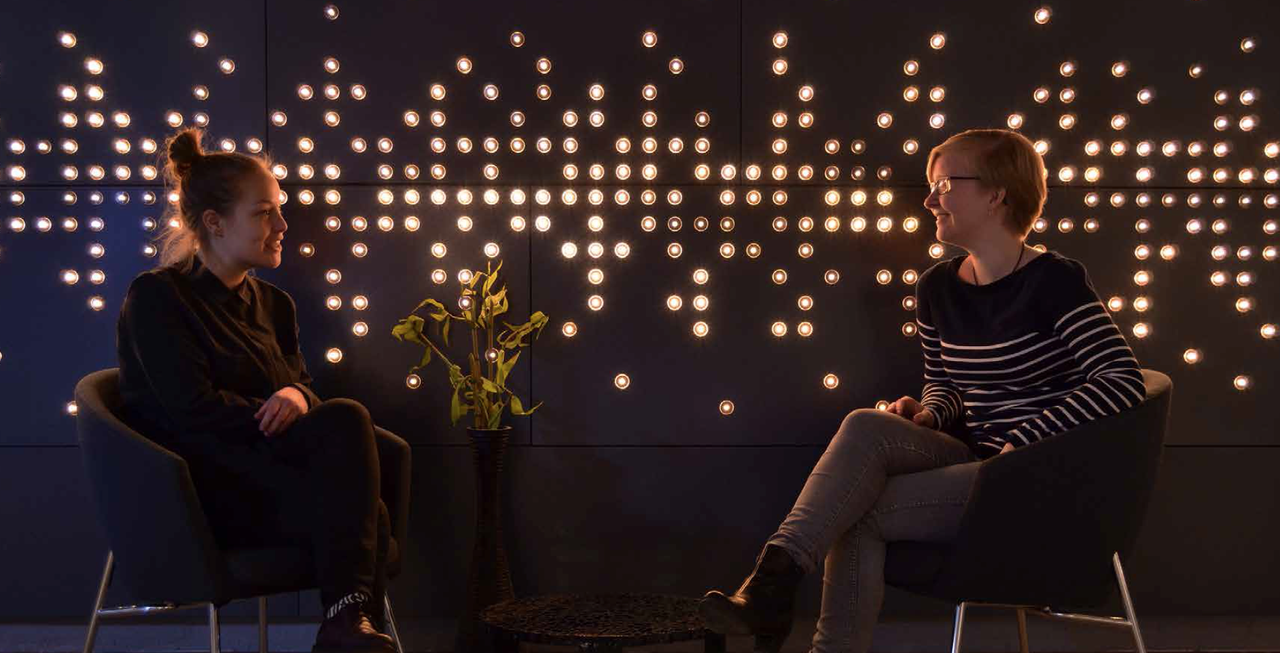Embedded Lighting - Developing New Lighting Applications for Modern Architectural Projects by Philips Lighting
When the era of LED lighting started, everybody talked about the new age of lighting with new opportunities. While many lighting concepts are still pure replacements of the conventional light sources, with the maturation of this technology, more and more new concepts are realized, and the future perspectives are even more exciting. Brad Koerner, Venture Manager - Philips Luminous Patterns at Philips Lighting, shows examples, explains why such new concepts are desirable, and discusses which technologies support the introduction of new lighting applications.
Many architects and interior designers have a difficult time understanding the potential for new applications of light permitted by LED technologies. Architecture is traditionally framed as a passive form set in light - imagine an ancient stone wall illuminated by an oil-burning lamp. This mindset is perhaps best exemplified and perpetuated in modern architecture by Le Corbusier’s famous quote:
“Architecture is the masterly, correct and magnificent play of masses brought together in light.”
Figure 1: Hot, dangerous and fragile - the classic objectification of lighting fixtures
Man-made lighting technologies, which have historically been hot, fragile and dangerous, needed to be contained and therefore objectified, leading most designers to treat them either as architectural adornment or a nuisance to be concealed.
LED lighting technology eliminates the fundamental problems of previous electric light sources, to the point where luminous features can potentially be embedded directly into architectural walls, floors and ceilings. This ability to “embed” lighting into architectural materials challenges the lighting industry to rethink how lighting is designed, specified and fabricated.
Why Designers Would Embed Lighting into Their Walls or Ceilings
Contemporary architecture is largely based in mid-century modernism, which strove for a minimalistic aesthetic. Mid-century designers reacted against the excessive and ubiquitous ornamentation that pervaded classical architecture. Mies van der Rohe’s famous quip “less is more” expressed a desire to strip away garish ornamentation in favor of a more simple presentation of material and form. A big part of that “garish” ornamentation was of course, decorative light fixtures. The crystal, glass, intricate metal work, and warm glow that constituted classical chandeliers, sconces and pendants were tossed in favor of “invisible” light sources such as recessed downlights, wall washers, and discrete spot lights that highlighted gorgeous - and expensive - materials such as marble floors, bronze trim, and rosewood wall panels.
Figure 2: Less is more - modernism stripped away decoration in favor of material and form
But in the 1970’s and 1980’s the exquisite materials of the early modernist masterpieces were dumbed-down into the bland commercial materials that came to dominate interior design: gypsum wall board, acoustic ceiling tiles, wall-to-wall carpet. Uniformity of experience came to dominate, too: Lighting designers became obsessed with eliminating glare and delivering constant lux levels throughout a space, throughout the day. The classical experiences of material variety, highlights and shadows, temporal changes, and subtle animation were industrialized into a homogenous, uniform, and unchanging light. The result is oppressive, unmemorable, and unattractive.
However, contemporary architects, while still largely rooted in modernism, are reinvigorating architectural design with more visual richness through use of parametric forms, geometric patterns, and innovative use of low-cost materials. In this context, embedded lighting provides a fresh new technique with which to create innovative and eye-catching spaces.
Figure 3: The oppressive uniformity of contemporary lighting paradigms
Exploring Patterns of Light
To what effect does embedded lighting have on the experience of space? Let’s consider four characteristics of embedded light that have tremendous impact on the quality of a space:
• The style of light effect selected
• The composition or patterning of the light effect
• The dynamic animation of the luminous pattern
• The material expression of the surface
Style of light effect
LED lighting allows for tremendous innovation in optical effects. Tiny LED sources can be discretely integrated with creative optics or with decorative shrouds either inset or protruding from the wall surface. A direct-view optic creates a feeling of brilliance; an indirect or grazing light effect creates a heightened play of shadows and texture; and a diffuse luminous surface lends itself well as a background to complicated graphic designs. The light itself can take on colors as warm as candlelight to as cool as the blue sky or as technicolor as a paint shop.

Figure 4: Sparkle and brilliance - integrating the qualities of candlelight into an architectural surface
Composition or patterning of light
To generate visual richness at the scale of an architectural wall or ceiling surface typically requires a panelized or repetitive surface, leading to a natural inclusion of decorative patterns. Spanning across large areas, patterns of stylish light effects makes a big impact on a space like a lobby or restaurant interior.
 Figure 5a&b: Graphics, patterns, and shadow play - ...
Figure 5a&b: Graphics, patterns, and shadow play - ...
Dynamic animation of the luminous pattern
Humans are naturally attracted by movement, which is part of our base survival instinct. Movement creates pleasurable visual sensations: Dappled sunlight reflecting off a lake mesmerizes; flickering candlelight enchants; sequenced brilliance from a movie theatre marquee attracts us. Animation has an inherent capacity to make us feel comfortable, to make a space feel more natural and attractive.

...embedded lighting holds enormous creative potential
Material expression of the surface
Embedding a luminous feature into a matte-white surface versus a glossy-black surface has a wildly different overall impact. Fusing the ephemeral magic of light plus the tactility of a material creates a whole new range of surface expressions that support many different thematic styles and project types. Interior designers and architects gain a new tool to craft occupants’ experiences of an elevator lobby, waiting room, or stylish boutique. Figure 6: Embedded lighting adds visual richness to a space
Figure 6: Embedded lighting adds visual richness to a space Figure 7: Example for the material expression of surface with embedded lighting
Figure 7: Example for the material expression of surface with embedded lighting
Mass-Customization of Embedded Lighting
In order to embrace the potential of embedded lighting, designers need a cost-effective system to visualize, specify and install complete compositions of luminous features in architectural surfaces.
The architectural design and construction process is largely adopting a digital workflow, with a growing portion of buildings being designed and built using building-information-modeling (“BIM”) systems. BIM allows for complex architectural systems to be precisely designed, visualized with photorealistic accuracy and efficiently detailed for construction. And beyond BIM, leading architects are increasingly turning to a technique called “parametric” or “generative” design to create the wildly expressive sculptural forms found in so many of the world’s signature architectural projects.
The architectural lighting industry is also transforming by largely adopting a “just-in-time” lean production workflow. Lean principles have demonstrated radical improvements in the manufacturing sector, effectively producing products with short lead times only once an order has been placed. No longer are products built for inventory, and variation in product lines can be readily accommodated without huge carrying costs. And beyond lean, digital fabrication techniques such as CNC laser cutting, digital printing, 3D printing, etc. are, in effect, “turbocharging” lean production by producing endless variations of products.
Digital fabrication systems in lean production flows align readily to the core notion of parametric design - that design, engineering or production constraints can be parametrized and coded into easy-to-use software tools that can generate wild variety with little effort. If a product system is designed with key parameters varied directly through digital fabrication, customized design effectively adds zero cost to the end product.
Figure 8: Parametric design - Rhino Software with Grasshopper plug-in, modeling a repetitive tiled pattern of embedded lighting
Future Production Technologies for Embedded Lighting
LED lighting can already be incorporated into digital production systems in a variety of ways. One common example is fixing standard LED light nodes in architectural panels that are digitally fabricated via subtractive CNC cutting.
Looking toward to the future, it is readily conceivable that the actual LED light engine and associated electronics could be additively fabricated directly into architectural panels; plus the panels themselves may be digitally fabricated. Such a combination will allow for wild architectural forms with lighting systems seamlessly integrated.
For example, on the light engine side of the solution, technologies such as conductive inks and conductive adhesives are advancing fast enough that printed electronics are quickly becoming practical for production volumes. As with all the advances in digital printing technologies, printed electronics hold the promise of both digital customization and high-volume, low-cost production.
Another example of light engine innovation is the field of “e-textiles”, where conductive traces are woven into various types of fabrics. Many types of fabrics are already used in architectural interiors and exteriors. It seems a natural opportunity to add lighting to fabric surfaces.
On the architectural side of the solution, there are many recent examples of architects and engineers exploring CNC production technologies for building structures and surfaces. CNC milling of decorative interior architectural panels has been available for many years. CNC milling of formwork is already commonly used in the creation of large-scale fiberglass panels. The more avant-garde researchers are testing large-scale 3D printing of concrete. There have even been experiments of in-situ CNC woven structures of fiberglass or carbon-fiber strands to create gorgeous new styles of architectural surfaces.
To reiterate: Many of the best innovations in the lighting industry are coming from outside the industry. Robotics, ship building, textile production, digital printing - innovators should cast a wide net to find the next architectural lighting innovations.
 Figure 9: Mass-customization - laser cutting is a common digital production process that enables parametric design
Figure 9: Mass-customization - laser cutting is a common digital production process that enables parametric design
Creating a Complete System for Embedded Lighting
There are numerous challenges and opportunities the industry faces in driving the acceptance of new lighting applications.
Fighting the “paradox of choice” will be a key area of innovation. From a marketing and sales perspective, if you provide a customer too much choice, they are paralyzed in making a decision. How do you help your customers quickly and efficiently find or create exactly what they want?
Embedded lighting systems must integrate directly into architects’ existing design and engineering work flows. Due to its fundamental nature as an architectural system, embedded lighting needs to be directly fused into the BIM design process and the more advanced parametric design processes. How do you develop lighting systems natively in BIM?
The true potential of embedded lighting is in the dynamics associated with digital control; but if the industry can’t reduce the overall project costs of these offerings, they will remain forever a luxury feature for only the most high-end projects. How do you efficiently simulate, specify, program and commission cloud-connected, embedded lighting systems? Figure 10: Embedded lighting profoundly impacts the way people feel in architectural spaces
Figure 10: Embedded lighting profoundly impacts the way people feel in architectural spaces
Conclusion
When dynamic lighting fuses into the material surfaces of a space, it has the potential to make a profound impact on the way people feel, the way they act, the way they interact with others, the way they interact with the space itself. Such “embedded lighting” has the potential to tell stories; it has the potential to make a statement with unique visual attraction in a multitude of applications. Embedded lighting breaks through the tired paradigms of light bulbs and light fixtures and opens up exciting new opportunities for both the design and delivery of architectural lighting systems.

